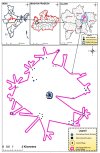Antibiotic Prescribing by Informal Healthcare Providers for Common Illnesses: A Repeated Cross-Sectional Study in Rural India
- PMID: 31491900
- PMCID: PMC6783982
- DOI: 10.3390/antibiotics8030139
Antibiotic Prescribing by Informal Healthcare Providers for Common Illnesses: A Repeated Cross-Sectional Study in Rural India
Abstract
Informal healthcare providers (IHCPs) are predominant healthcare providers in rural India, who prescribe without formal training. Antibiotic prescription by IHCPs could provide crucial information for controlling antibiotic resistance. The aim of this study is to determine the practices and seasonal changes in antibiotic prescribing for common illnesses by IHCPs. A repeated cross-sectional study was conducted over 18 months, covering different seasons in the rural demographic surveillance site, at Ujjain, India. Prescriptions given to outpatients by 12 IHCPs were collected. In total, 15,322 prescriptions for 323 different complaint combinations were analyzed, of which 11,336 (74%) included antibiotics. The results showed that 14,620 (95%) of antibiotics prescribed were broad spectrum and the most commonly prescribed were fluoroquinolones (4771,31%), followed by penicillin with an extended spectrum (4119,27%) and third-generation cephalosporin (3069,20%). Antibiotics were prescribed more frequently in oral and dental problems (1126,88%), fever (3569,87%), and upper respiratory tract infections (3273, 81%); more during the monsoon season (2350,76%); and more frequently to children (3340,81%) than to adults (7996,71%). The study concludes that antibiotics were the more commonly prescribed drugs compared to other medications for common illnesses, most of which are broad-spectrum antibiotics, a situation that warrants further investigations followed by immediate and coordinated efforts to reduce unnecessary antibiotic prescriptions by IHCPs.
Keywords: Healthcare providers; India; antibiotics; infectious diseases; prescription; rural population.
Conflict of interest statement
The authors declare no conflicts of interest.
Figures



Similar articles
-
Determinants and pathways of healthcare-seeking behaviours in under-5 children for common childhood illnesses and antibiotic prescribing: a cohort study in rural India.BMJ Open. 2021 Dec 3;11(12):e052435. doi: 10.1136/bmjopen-2021-052435. BMJ Open. 2021. PMID: 34862290 Free PMC article.
-
Understanding Internal and External Drivers Influencing the Prescribing Behaviour of Informal Healthcare Providers with Emphasis on Antibiotics in Rural India: A Qualitative Study.Antibiotics (Basel). 2022 Mar 29;11(4):459. doi: 10.3390/antibiotics11040459. Antibiotics (Basel). 2022. PMID: 35453210 Free PMC article.
-
Adherence to treatment guidelines for acute diarrhoea in children up to 12 years in Ujjain, India--a cross-sectional prescription analysis.BMC Infect Dis. 2011 Jan 28;11:32. doi: 10.1186/1471-2334-11-32. BMC Infect Dis. 2011. PMID: 21276243 Free PMC article.
-
Identifying the know-do gap in evidence-based neonatal care practices among informal health care providers-a cross-sectional study from Ujjain, India.BMC Health Serv Res. 2020 Oct 21;20(1):966. doi: 10.1186/s12913-020-05805-2. BMC Health Serv Res. 2020. PMID: 33087124 Free PMC article.
-
Antibiotic Use and Misuse in Dentistry in India-A Systematic Review.Antibiotics (Basel). 2021 Nov 26;10(12):1459. doi: 10.3390/antibiotics10121459. Antibiotics (Basel). 2021. PMID: 34943671 Free PMC article. Review.
Cited by
-
Determinants and pathways of healthcare-seeking behaviours in under-5 children for common childhood illnesses and antibiotic prescribing: a cohort study in rural India.BMJ Open. 2021 Dec 3;11(12):e052435. doi: 10.1136/bmjopen-2021-052435. BMJ Open. 2021. PMID: 34862290 Free PMC article.
-
What are the challenges for antibiotic stewardship at the community level? An analysis of the drivers of antibiotic provision by informal healthcare providers in rural India.Soc Sci Med. 2021 Apr;275:113813. doi: 10.1016/j.socscimed.2021.113813. Epub 2021 Mar 6. Soc Sci Med. 2021. PMID: 33721743 Free PMC article.
-
Characteristics of a Nationwide Voluntary Antibiotic Resistance Awareness Campaign in India; Future Paths and Pointers for Resource Limited Settings/Low and Middle Income Countries.Int J Environ Res Public Health. 2019 Dec 16;16(24):5141. doi: 10.3390/ijerph16245141. Int J Environ Res Public Health. 2019. PMID: 31888272 Free PMC article.
-
Effect of knowledge of informal poultry drug prescribers on their attitude and practice toward antimicrobial use, residues, and resistance in Bangladesh.Vet World. 2023 Sep;16(9):1821-1828. doi: 10.14202/vetworld.2023.1821-1828. Epub 2023 Sep 14. Vet World. 2023. PMID: 37859963 Free PMC article.
-
Unlocking the potential of informal healthcare providers in tuberculosis care: insights from India.BMJ Glob Health. 2024 Feb 26;9(2):e015212. doi: 10.1136/bmjgh-2024-015212. BMJ Glob Health. 2024. PMID: 38413099 Free PMC article. No abstract available.
References
-
- WHO Pre-Antibiotic Era Looming Large—The World is Almost Out of Time. [(accessed on 1 July 2019)];2014 Available online: http://www.searo.who.int/mediacentre/features/2014/rd-statement-amr2014/en/
-
- Penicillin A.F. Nobel Lecture Dec 11. [(accessed on 1 July 2019)];1945 Available online: http://www.nobelprize.org/nobel_prizes/medicine/laureates/1945/fleming-l....
-
- WHO Global Action Plan on Antimicrobial Ressitance. [(accessed on 1 July 2019)];2015 Available online: http://apps.who.int/iris/bitstream/handle/10665/193736/9789241509763_eng....
-
- CDC Report on “Antibiotic Resistance Threats in the United States”. [(accessed on 1 July 2019)];2013 Available online: http://www.cdc.gov/drugresistance/threat-report-2013/
-
- Jacob J.T., Muliyil J. Public health is infrastructure for human development. Indian J. Med. Res. 2009;130:9–11. - PubMed
Grants and funding
LinkOut - more resources
Full Text Sources

